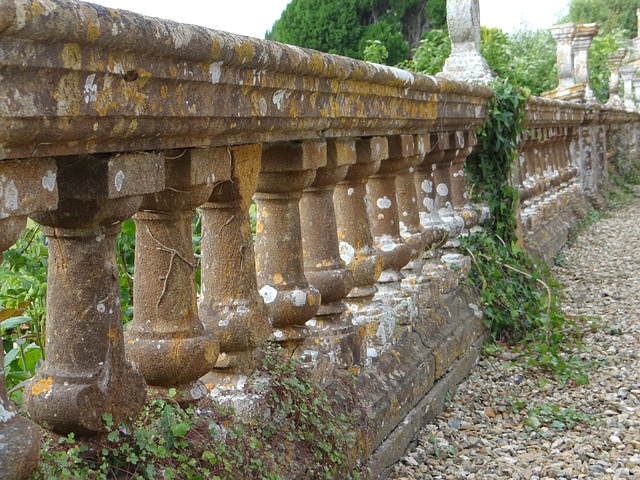Railings
Contents |
[edit] Introduction
Railings are used on stairs, balconies, galleries, decks, ramps, walkways and so on as a means of providing separation, support and safety.
Railings can be made from a very wide range of materials:
- Wrought or cast iron.
- Stainless steel.
- Timber.
- Plastic.
[edit] Balustrade
Railings differ from balusters which are made of stone, wood or metal, which are usually rounded or vase-shaped and support a rail or coping in a balustrade. They are common in classical forms of architecture. The balusters of a stairway together with handrail is known by the term banister.
A survey carried out by stair part specialist Jackson Woodturners revealed that only 15% of the public know the correct name for a balustrade.
NB See SCOSS Alert Dec 2019, Glass balustrades may pose a serious risk to safety.
[edit] Guard rails
Guard rails tend to be a restrictive form of railing, and aim to create the protective limitation of a boundary as opposed to handrails which aim to provide support. Many public spaces are fitted with guardrails as a means of preventing access and maintaining safety.
The Work at Height Regulations 2005 require that, for construction work, railings must have a minimum height of 950 mm and any gap between top and any intermediate rail should not exceed 470 mm.
Approved Document K of the Building Regulations requires that in a building that may be used by young children:
- The spaces between railings should be close enough together to prevent a 100 mm sphere from passing through.
- Horizontal rails should be avoided to prevent climbing.
See also Guarding.
[edit] Handrails
Approved document K defines a handrail as ’..a rail, at hand height or a little higher, for people to hold for support.’This can be useful for example when ascending or descending stairs or ramps.
Approved Document K requires that:
- The top of the handrail should be positioned 900-1000 mm from the pitch line or floor.
- The handrail may form the top of a guarding as long as the heights are matched.
- A handrail should be provided on both sides of stairs that are 1 m wide or wider.
- If stairs are more than 2m wide, then they should be divided into flights of no less than 1,000mm.
- Handrails should be 50-75 mm away from the wall to which they are attached.
- Circular handrails should be 32-50 mm in diameter.
- Non-circular handrails should be 50 mm wide and 39 mm deep, usually with rounded edges.
In addition to this, for buildings other than dwellings:
- Where there is a full guarding, and a second (lower) handrail, it should be 600 mm above the pitch line of the steps of ramp surface.
- Handrails should not project into an access route.
- Handrails should contrast visually without being highly reflective.
- Handrails should be slip-resistant and not liable to become too hot or cold to the touch.
- Handrails should continue, at least 300mm beyond the top and bottom of the stairs and should be finished in a way that reduces the risk of clothing being caught.
In dwellings and common access areas in buildings that contain flats:
- Handrails on one or both sides should be provided for ramps less than 1 m wide.
- Ramps wider than 1 m should have handrails on both sides.
- Handrails are not needed for ramps 600 mm or less in height.
- Handrails should be positioned 900-1000 mm above the surface of the ramp.
NB According to Approved Document K, Protection from falling, collision and impact, 'guarding' is ‘…a barrier that denies pedestrians or vehicles access to another area, for example the floor below’.
[edit] Related articles on Designing Buildings
Featured articles and news
CIOB and CORBON combine forces
To elevate professional standards in Nigeria’s construction industry.
Amendment to the GB Energy Bill welcomed by ECA
Move prevents nationally-owned energy company from investing in solar panels produced by modern slavery.
Gregor Harvie argues that AI is state-sanctioned theft of IP.
Heat pumps, vehicle chargers and heating appliances must be sold with smart functionality.
Experimental AI housing target help for councils
Experimental AI could help councils meet housing targets by digitising records.
New-style degrees set for reformed ARB accreditation
Following the ARB Tomorrow's Architects competency outcomes for Architects.
BSRIA Occupant Wellbeing survey BOW
Occupant satisfaction and wellbeing tool inc. physical environment, indoor facilities, functionality and accessibility.
Preserving, waterproofing and decorating buildings.
Many resources for visitors aswell as new features for members.
Using technology to empower communities
The Community data platform; capturing the DNA of a place and fostering participation, for better design.
Heat pump and wind turbine sound calculations for PDRs
MCS publish updated sound calculation standards for permitted development installations.
Homes England creates largest housing-led site in the North
Successful, 34 hectare land acquisition with the residential allocation now completed.
Scottish apprenticeship training proposals
General support although better accountability and transparency is sought.
The history of building regulations
A story of belated action in response to crisis.
Moisture, fire safety and emerging trends in living walls
How wet is your wall?
Current policy explained and newly published consultation by the UK and Welsh Governments.
British architecture 1919–39. Book review.
Conservation of listed prefabs in Moseley.
Energy industry calls for urgent reform.



























